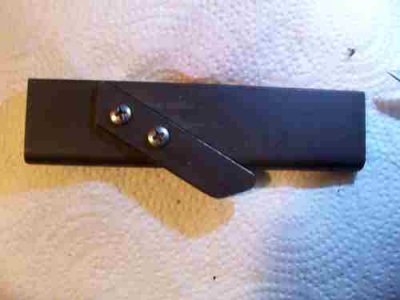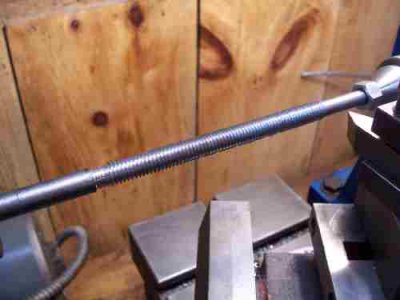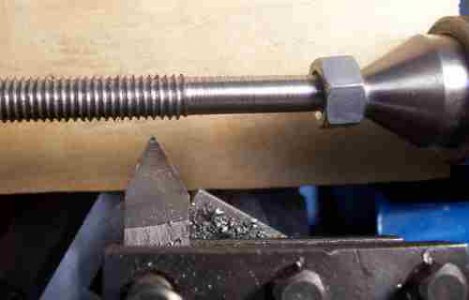- Joined
- Feb 18, 2016
- Messages
- 451
I'm actually making a collet drawbar. But for the last three days I've been setting up to cut the threads on it. The reason it took so long is because this is the first thread I ever cut on this lathe and I had to learn how to do it. By the way, a shout out to "This Old Tony" and a thank you for the videos he made on grinding a thread cutting tool and on how to cut threads on a lathe. I used his procedure and it worked out really well.
First order of the day was to figure out which gears to use. This is the first time I ever changed the gears in my lathe. No quick change tool box. And trust me, this lathe is NOT user-friendly when it comes to changing gears. What a pain. Very poor design. Everything is really hard to get at and when you take the bolts out that hold the gears on the nut behind the bolt falls out. Then you need to try to hold that nut in place when putting on the new gears and there's no room to get your fingers in there. A very bad design to be sure. I'll need to redesign this lathe and make some kind of clip or cage to hold the nut in place when you remove the gears.
In any case, I finally got the proper gears on the lathe.
The next step was to make the cutting tool. I chose a 1/2 square tool bit. I had one an old one on hand that had never been ground on one end. So I built a sled for my tool post grinder to hole the tool bit at 30 degrees. It's not much of a sled but it did work. It took me about two days to grind that 1/2" square bit down to a 60 degree point. I probably would have benefited by having a coarser grinding wheel.

Finally with the tool made and the proper gears installed I cut the thread. First thread I ever cut on a lathe. As I mentioned previously I used Tony's method. Or at least the method he explained in his video. I set the compound to about 29 degrees. Set the table to zero when just touching the work. And then used the compound to increase the depth of cut on every pass. The rod wasn't quite straight either. So I had to take that into account. I had to touch-off at the most concentric point in the middle of area I was threading and use that as my scratch pass. From there I just keep cycling through the process cutting a few thou each pass. This rod was some tough stuff too. So I actually ran through each cutting depth twice and it took off as much material the second pass as it did the first time through. So apparently this was a necessary double-pass on each cut. But I was patient and it worked out well. As you can see in the photo I had a nut on the end of the shaft that I could use to test the thread as I progressed.

Here's a close up of the thread and the cutting tool. It turned out pretty nice considering it was my first thread ever. And when I was finished the nut went down the entire length without a problem. That was good because I was afraid it might bind up along the way because of the bend in the rod. But apparently that wasn't a problem. I think this rod was originally an axle on a small cart of some kind.

In any case, that's what I did in my shop today, and for the last three days. I changed the feed gears back to the original gears after I was done, and again, what a pain. I'm definitely going to need to make changing gears easier. I'm planning on making quite a few threaded projects. So I'll be cutting threads of all difference sizes as time goes on.
The thread I cut here was 3/8 - 16
As I've said, this is a drawbar I'm making for MT3 collets for this lathe.
I know this isn't a very exciting project, but it was for me.
My first thread turned out to be a total success. That's not too shabby. And it was even cut on an old bent rod of unknown steel alloy. Definitely some tough stuff whatever it is.
First order of the day was to figure out which gears to use. This is the first time I ever changed the gears in my lathe. No quick change tool box. And trust me, this lathe is NOT user-friendly when it comes to changing gears. What a pain. Very poor design. Everything is really hard to get at and when you take the bolts out that hold the gears on the nut behind the bolt falls out. Then you need to try to hold that nut in place when putting on the new gears and there's no room to get your fingers in there. A very bad design to be sure. I'll need to redesign this lathe and make some kind of clip or cage to hold the nut in place when you remove the gears.
In any case, I finally got the proper gears on the lathe.
The next step was to make the cutting tool. I chose a 1/2 square tool bit. I had one an old one on hand that had never been ground on one end. So I built a sled for my tool post grinder to hole the tool bit at 30 degrees. It's not much of a sled but it did work. It took me about two days to grind that 1/2" square bit down to a 60 degree point. I probably would have benefited by having a coarser grinding wheel.

Finally with the tool made and the proper gears installed I cut the thread. First thread I ever cut on a lathe. As I mentioned previously I used Tony's method. Or at least the method he explained in his video. I set the compound to about 29 degrees. Set the table to zero when just touching the work. And then used the compound to increase the depth of cut on every pass. The rod wasn't quite straight either. So I had to take that into account. I had to touch-off at the most concentric point in the middle of area I was threading and use that as my scratch pass. From there I just keep cycling through the process cutting a few thou each pass. This rod was some tough stuff too. So I actually ran through each cutting depth twice and it took off as much material the second pass as it did the first time through. So apparently this was a necessary double-pass on each cut. But I was patient and it worked out well. As you can see in the photo I had a nut on the end of the shaft that I could use to test the thread as I progressed.

Here's a close up of the thread and the cutting tool. It turned out pretty nice considering it was my first thread ever. And when I was finished the nut went down the entire length without a problem. That was good because I was afraid it might bind up along the way because of the bend in the rod. But apparently that wasn't a problem. I think this rod was originally an axle on a small cart of some kind.

In any case, that's what I did in my shop today, and for the last three days. I changed the feed gears back to the original gears after I was done, and again, what a pain. I'm definitely going to need to make changing gears easier. I'm planning on making quite a few threaded projects. So I'll be cutting threads of all difference sizes as time goes on.
The thread I cut here was 3/8 - 16
As I've said, this is a drawbar I'm making for MT3 collets for this lathe.
I know this isn't a very exciting project, but it was for me.

My first thread turned out to be a total success. That's not too shabby. And it was even cut on an old bent rod of unknown steel alloy. Definitely some tough stuff whatever it is.


